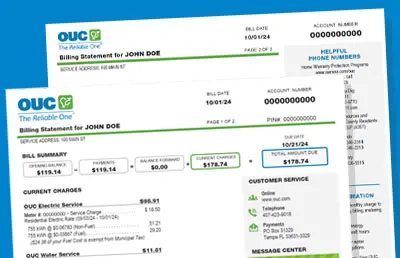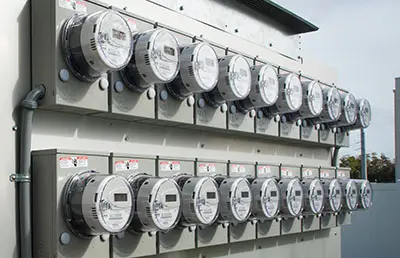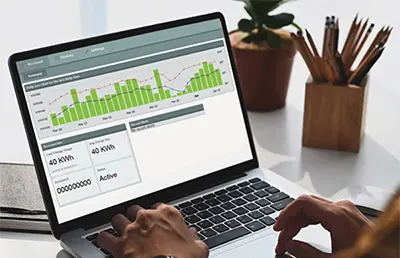All rates are effective as of October 01, 2025.
Electric Rates
Miscellaneous Charges
| Description | Charge |
|---|---|
| Customer Charge This charge is applied when initiating an account at one service location in OUC’s records, or for transferring the account to a different location, and includes any combination of OUC services at a given location that are activated on the same service order on the same day. | $25.00 |
| Cut Seal Fee This fee is applied when OUC finds that a meter box seal has been cut by someone other than OUC and without OUC’s authorization but does not constitute utility theft/tampering or unauthorized use. | $100.00 |
| Electric Meter Test At a customer’s request, OUC will test a meter for accuracy at no charge once in a 12-month period. A second test may be requested within 12 months and carries this published charge unless the meter is found to be registering incorrectly. | One free test in 12 months $85.00 – 2nd test in 12 months |
| Electric Service Initiation Charge – No Meter Present When a new electric meter is set at a location that has not previously had service, this charge applies to cover the costs associated with travel and labor to perform the installation. | $170.00 |
| Electric Service Initiation Charge – Multiple Electric Meter Sets For multiple meters being set, the first meter is charged the full initiation cost and each additional meter is assessed a lower charge. To qualify for the reduced cost, the meters must be set at one location, in the same customer’s name, and during the same site visit. | $15.00 per meter |
| Electric Service Truck Trip Charge The cost for an electric service truck to make a trip to a customer’s location, which, upon arrival of the electric service truck, is not ready, causing additional trips. | $70.00 per trip |
| Field Trip Fee The cost for a field employee to travel to a customer’s location to perform work. Such work includes but is not limited to, unlocking/locking (sealing) meter bases, verifying that power or water is either on or off, or second trips after service was left off for safety reasons. | $35.00 |
| Late Payment Fee A late payment fee is assessed on the total unpaid past due amount five days after the due date. | 1.5% of total amount due or $5.00 (whichever is greater) |
| Non-Payment Removal/Reinstallation of a Water Meter This charge is applied when a water meter is removed due to non-payment issues or meter tampering. Reinstallation will only be performed during normal business hours. | $85.00 |
| Reread Meter – Electric & Water Upon request by a customer, OUC will reread a meter for accuracy at no charge once in a 12-month period. A second request will be charged unless it is determined that the previous reading was incorrect. | One free in 12 months $35.00 – second reread in 12 months |
| Returned Check Charge This charge is applied when a check, whether paper or electronic, is returned by the bank on which it is drawn. | $25.00 |
| Service Reconnect Fee at Meter This charge is applied when service is disconnected for non-payment of a bill. The bill must be paid to resume service. Once payment is made, digital meters will reconnect automatically. Payments made after 8 p.m. for disconnected analog meters will be reconnected the next day. | $45.00 weekdays 6 a.m. to 8 p.m., (excluding holidays) |
| Service Reconnect Fee at Transformer This charge is applied when a meter is not accessible to OUC personnel and service is disconnected at the utility pole for non-payment of a bill. The bill must be paid to resume service. | $225.00 weekdays 6 a.m. to 8 p.m., (excluding holidays) |
| Temporary Electric Connection Charge – “Saw Rig” This charge is applied when setting up temporary services for construction purposes. | $310.00 |
| Temporary Electric Underground Connection Charge – “TUG” This charge is applied for meter service of concrete block residential detached homes with underground electric service. | $170.00 |
| Theft/Tamper or Unauthorized Use of Service Investigation Charge This charge shall be in addition to the Utility Tamper Fee for all time beyond one hour and will be charged for expenses incurred in the investigation of theft of service, tampering, or the unauthorized use of service. | $115.00 per hour for all hours beyond one hour |
| Utility Tamper Fee The fee is applied when OUC finds that any meter has been altered or tampered with, or other utility equipment, in such a manner that would prevent a meter from registering utilities used by a customer. The customer will be charged for any damaged equipment. The customer’s account will be researched and then billed for any unauthorized or un-metered consumption that occurred as a result of the theft or tampering. A review of the customer’s deposit will occur. If necessary, an additional deposit may be assessed. | $200.00 for the first occurrence of meter tampering $400.00 for the second occurrence of meter tampering $800.00 for each additional occurrence after the second occurrence |
| Water Meter Test This service charge is applied when a customer requests a water meter assessment and it is determined the meter is registering accurately. If the meter is not registering accurately, there is no charge and the meter will be repaired or replaced. | 2” meters and smaller – $180.00 Meters larger than 2” – $430.00 |
In the event of any discrepancy between the rates published here and OUC’s Tariff filed with the Florida Public Service Commission, the Tariff rates shall prevail.
Electric Rate – FAQs for Mid and Large Commercial Customers
What is demand (kW) vs. energy (kWh)?
Demand is the maximum amount of power, measured in kilowatts (kW), consumed at one point in time. Energy is the total amount of electricity consumed by the customer during the billing period and is measured in Kilowatt-Hours (kWh).
It’s similar to the relationship between a car’s speed and its odometer. The total distance the car travels (energy) is recorded by the odometer. The car will speed up and slow down, but as long as it is traveling, the odometer will continue to turn. The higher the speed of the car (demand), the faster the odometer turns.
How do demand and energy affect billing?
Demand is not determined by the amount of time your equipment is running. It is a function of how much power your equipment requires and how much of your equipment is running at a given time. The more equipment that operates simultaneously, the higher the demand.
Therefore, if your business requires sizeable peaks of energy—even if your equipment is only running for a short period of time—the amount of power it consumes (energy) at a point in time affects your bill. OUC must be able to supply the electricity and have the infrastructure in place to deliver the energy to you, such as power plants and distribution systems.
How is peak demand determined?
Most businesses have a meter that tracks and records demand in 15-minute intervals for each billing period. A customer is billed for the highest 15-minute kW demand used by their facility, known as peak demand. OUC must be able to provide that level of power in order for the customer’s equipment to run at its highest operating need.
How can I lower my Demand charges?
Your business energy auditor can help you determine if you qualify to move to a different rate class. Electricity use is charged differently depending on the rate class. Schedule a FREE Business Energy Audit. An OUC conservation specialist will visit your business and make recommendations based on your needs.




